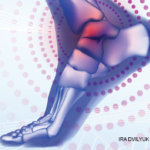How did a knuckle-walking ape transform to an upright, bipedal hominid? Not quickly. A number of musculoskeletal changes occurring over a period of several million years supported this shift to bipedalism. In order to walk, hominids had to sacrifice their agility as tree climbers. Their spines needed to be redesigned to include a lumbar curve to position the upper body above, rather than in front of the hips, and femurs had to be angled inward so the knees would be more centrally positioned than the hips. Hips became curved to the side, permitting the muscles along the side of the pelvis to stabilize the body’s center of gravity when one foot needed to be planted on the ground. The hominid foot began to resemble the human form, with robust heels, a large big toe partly in line with the other toes and a partial arch.3 Perhaps one of the most important yet overlooked changes in body structure was related to foot pronation.
Pronation is an important motion that shifts weight onto the medial side of the foot in climbing apes and serves a role in weight transfer, shock absorption and negotiation of uneven surfaces. As apes descended from the trees and transformed from being climbers to walkers, they needed to be able to accommodate both terrains. This required an increasingly mobile foot that could provide support along its medial pronated aspect, along with strong, stabilizing anatomies at the knee and the hip.4 These highly intricate foot biomechanics evolved over millennia. The end result was the human foot, which the Renaissance polymath Leonardo da Vinci considered, “a masterpiece of engineering and a work of art.”
Walk On
Fast forward a few more millennia and here we are today. When a weight-bearing joint fails to function, it can now be replaced. One can only imagine the difficulties facing a patient with advanced osteoarthritis of a hip or a knee living any time prior to the latter half of the 20th century. There were no realistic ways to address the misery of end-stage osteoarthritis. For the afflicted patient, ambulation was severely limited, and without narcotic analgesics the pain was nearly continuous. Life was miserable.
It was just a little more than 50 years ago that John Charnley, a British orthopedic surgeon, created the first successful hip implant. Within a few decades, knee arthroplasty became a widely available procedure. The continued stubborn resistance of osteoarthritis to most, if not all, therapeutic interventions assures the long-term viability of the orthopedic implant industry.
